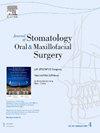法国儿童下颌骨骨折治疗的评估。
IF 2
3区 医学
Q2 DENTISTRY, ORAL SURGERY & MEDICINE
Journal of Stomatology Oral and Maxillofacial Surgery
Pub Date : 2025-10-01
DOI:10.1016/j.jormas.2025.102389
引用次数: 0
摘要
由于儿童特殊因素,如下颌骨生长和牙细菌的存在,儿童下颌骨骨折目前的管理挑战。很少有外科医生专门接受过治疗这些骨折的培训,也没有全国性或国际性的指导方针。治疗取决于几个因素,包括儿童的年龄和骨折的位置。治疗方案包括功能治疗、带或不带固定的闭合复位和手术。本研究的目的是基于一项全国调查,评估法国儿童下颌骨骨折的当前管理策略。一份基于两例不同年龄、不同部位出现下颌骨骨折的儿童临床病例的调查问卷,被发送给法国25个治疗儿童颌面外伤中心的儿科外科医生。问题集中在治疗的选择、术后指导和随访。对数据进行描述性分析。25个中心都回答了问卷。对于第一个病人,92%的外科医生让孩子住院。其中,76%的副椎体骨折选择切开复位内固定(ORIF), 72%的下颌骨骨折选择相同的入路。在大多数情况下,固定材料放置至少三个月。对于第二个病人,88%的外科医生也让孩子住院。对于髁突骨折,84%的患者选择功能治疗。56%的从业者选择ORIF治疗下颌骨骨折。关于可吸收板的使用,25个中心中只有1个使用了这种材料。关于外科医生的特殊培训,研究表明,在25个中心中:52%的中心报告有接受过儿科特殊培训的外科医生。48%的中心有机会接触到能够制造固位夹板的牙科修复师。这项研究在法国尚属首次。它强调了法国儿童下颌骨骨折管理的显著差异,并强调了标准化治疗方案的必要性。未来的研究应侧重于制定标准化的指导方针和评估长期结果,以改善手术和保守方法。本文章由计算机程序翻译,如有差异,请以英文原文为准。
Assessment of pediatric mandibular fracture management in France
Mandibular fractures in children present management challenges due to pediatric-specific factors such as mandibular growth and the presence of dental germs. There are few surgeons specifically trained to treat these fractures, and there are no national or international guidelines. Management depends on several factors, including the child’s age and the location of the fracture. Treatment options include functional treatment, closed reduction with or without immobilization, and surgery. The aim of this study was to assess the current management strategies for pediatric mandibular fractures in France, based on a national survey. A questionnaire based on two clinical cases of children of different ages, presenting mandibular fractures in different locations, was sent to the referring pediatric surgeon of 25 centers in France that manage pediatric maxillofacial trauma. The questions focused on the choice of treatment, postoperative instructions, and follow-up. The data were analyzed descriptively. Off the 25 centers, all responded to the questionnaire. For the first patient, 92 % of the surgeons hospitalized the child. Among them, 76 % opted for open reduction and internal fixation (ORIF) for the parasymphyseal fracture, and 72 % adopted the same approach for the mandibular body fracture. In most cases, the fixation material was left in place for at least three months. For the second patient, 88 % of the surgeons also hospitalized the child. For condylar fractures, 84 % chose functional treatment. 56 % of practitioners opted for ORIF for the mandibular body fracture. Regarding the use of resorbable plates, only 1 out of 25 centers used this type of material. Concerning the specific training of surgeons, the study shows that among the 25 centers: 52 % reported having surgeons with specific pediatric training. 48 % of the centers had access to a dental prosthetist capable of fabricating retention splints. This study is the first on this subject in France. It highlights significant variability in the management of pediatric mandibular fractures in France and underscore the need for standardized treatment protocols. Future studies should focus on developing standardized guidelines and evaluated long-term outcome to improve both surgical and conservative approaches
求助全文
通过发布文献求助,成功后即可免费获取论文全文。
去求助
来源期刊

Journal of Stomatology Oral and Maxillofacial Surgery
Surgery, Dentistry, Oral Surgery and Medicine, Otorhinolaryngology and Facial Plastic Surgery
CiteScore
2.30
自引率
9.10%
发文量
0
审稿时长
23 days
 求助内容:
求助内容: 应助结果提醒方式:
应助结果提醒方式:


